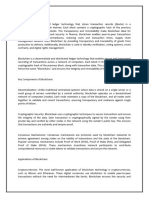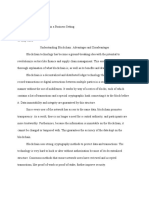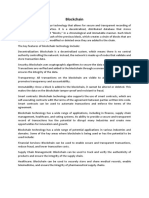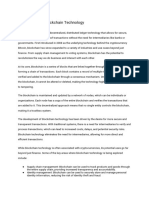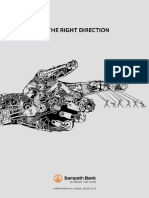0% found this document useful (0 votes)
22 views2 pagesBlockchain Technology Overview
Blockchain technology has emerged as a revolutionary force with transformative potential across industries. It provides a decentralized and immutable ledger that records transactions in a secure and transparent manner without intermediaries. Key components include decentralization through a distributed network of nodes, a distributed ledger where transaction data is stored across multiple nodes chronologically and immutably, and consensus mechanisms like proof of work that validate transactions. Blockchain finds applications in finance, supply chain management, healthcare, voting systems, and more. While it faces challenges like scalability and regulatory issues, its benefits of increased efficiency, reduced costs, and enhanced trust outweigh these challenges. Blockchain represents a paradigm shift that will profoundly impact global economies and societies.
Uploaded by
harshaks116Copyright
© © All Rights Reserved
We take content rights seriously. If you suspect this is your content, claim it here.
Available Formats
Download as DOCX, PDF, TXT or read online on Scribd
0% found this document useful (0 votes)
22 views2 pagesBlockchain Technology Overview
Blockchain technology has emerged as a revolutionary force with transformative potential across industries. It provides a decentralized and immutable ledger that records transactions in a secure and transparent manner without intermediaries. Key components include decentralization through a distributed network of nodes, a distributed ledger where transaction data is stored across multiple nodes chronologically and immutably, and consensus mechanisms like proof of work that validate transactions. Blockchain finds applications in finance, supply chain management, healthcare, voting systems, and more. While it faces challenges like scalability and regulatory issues, its benefits of increased efficiency, reduced costs, and enhanced trust outweigh these challenges. Blockchain represents a paradigm shift that will profoundly impact global economies and societies.
Uploaded by
harshaks116Copyright
© © All Rights Reserved
We take content rights seriously. If you suspect this is your content, claim it here.
Available Formats
Download as DOCX, PDF, TXT or read online on Scribd
/ 2















